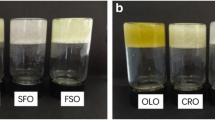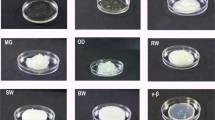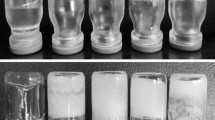Abstract
In this work, the potential application of propolis wax (PW) as a novel organogelator was investigated in different oils (canola, sesame, sunflower and flaxseed oil). PW at 2% (w/w) concentration produced a thick organogel at 5, 10 and 15 °C, with needle-like crystals, suggesting that PW is a relatively efficient structuring agent for organogel formation. The oil binding capacity of the organogel with canola oil was lower than that of the other organogels, and the gelling time of flaxseed organogel with lower oil viscosity was shorter. The X-ray diffraction measurements of the crystals showed β′-form crystals, with no influence of oil type. In FTIR results, no chemical intermolecular interactions that were observed indicated physical bonds in the organogel network. DSC analysis was carried out to obtain greater insight into the thermal behavior of PW organogels. No significant differences were observed. The textural properties of PW organogels were stable over 30 days of storage. Flaxseed oil organogel had the greatest firmness and stickiness. These results showed the effect of oil viscosity on PW gel behavior.







Similar content being viewed by others
Abbreviations
- GRAS:
-
Generally recognized as safe
- PW:
-
Propolis wax
- CO:
-
Canola organogel
- SEO:
-
Sesame organogel
- SUO:
-
Sunflower organogel
- FO:
-
Flaxseed organogel
- OBC:
-
Oil binding capacity
References
Patel AR, Rajarethinem PS, Grędowska A, Turhan O, Lesaffer A, De Vos WH, Van de Walle D, Dewettinck K (2014) Edible applications of shellac oleogels: spreads, chocolate paste and cakes. Food Funct 5:645–652
Öğütcü M, Yılmaz E (2015) Characterization of hazelnut oil oleogels prepared with sunflower and carnauba waxes. Int J Food Prop 18:1741–1755
Marangoni AG (2012) Organogels: an alternative edible oil-structuring method. J Am Oil Chem Soc 89:749–780
Dassanayake LSK, Kodali DR, Ueno S, Sato K (2009) Physical properties of rice bran wax in bulk and organogels. J Am Oil Chem Soc 86:1163–1173
Rocha JCB, Lopes JD, Mascarenhas MCN, Arellano DB, Guerreiro LMR, da Cunha RL (2013) Thermal and rheological properties of organogels formed by sugarcane or candelilla wax in soybean oil. Food Res Int 50:318–323
Patel AR, Babaahmadi M, Lesaffer A, Dewettinck K (2015) Rheological profiling of organogels prepared at critical gelling concentrations of natural waxes in a triacylglycerol solvent. J Agr Food Chem 63:4862–4869
Patel AR, Schatteman D, De Vos WH, Dewettinck K (2013) Shellac as a natural material to structure a liquid oil-based thermo reversible soft matter system. RSC Adv 3:5324–5327
Yılmaz E, Öğütcü M (2014) Properties and stability of hazelnut oil organogels with beeswax and monoglyceride. J Am Oil Chem Soc 91:1007–1017
Marcucci MC (1995) Propolis: chemical composition, biological properties and therapeutic activity. Apidologie 26:83–99
Burdock G (1998) Review of the biological properties and toxicity of bee propolis (propolis). Food Chem Toxicol 36:347–363
Enzo A, Tosi ER, Ortega Marta E, Cazzoli Ampelio F (2007) Food preservative based on propolis: bacteriostatic activity of propolis polyphenols and flavonoids upon Escherichia coli. Food Chem 104:1025–1029
Calligaris S, Mirolo G, Da Pieve S, Arrighetti G, Nicoli MC (2013) Effect of oil type on formation, structure and thermal properties of γ-oryzanol and β-sitosterol-based organogels. Food Biophys 23:1–7
Goli SAH, Kadivar M, Keramat J, Fazilati M (2008) Conjugated linoleic acid (ClA) production and lipase-catalyzed interesterification of purified ClA with canola oil. Eur J Lipid Sci Technol 110:400–404
Trusheva B, Trunkova D, Bankova V (2007) Different extraction methods of biologically active components from propolis: a preliminary study. Chem Cent J 1:1–4
Behera B, Sagiri SS, Pal K, Srivastava A (2013) Modulating the physical properties of sunflower oil and sorbitan monopalmitate-based organogels. J Appl Polym Sci 127:4910–4917
Hwang H-S, Kim S, Singh M, Winkler-Moser JK, Liu SX (2012) Organogel formation of soybean oil with waxes. J Am Oil Chem Soc 89:639–647
Laredo T, Barbut S, Marangoni AG (2011) Molecular interactions of polymer oleogelation. Soft Matter 7:2734–2743
Dassanayake LSK, Kodali DR, Ueno S, Sato K (2012) Crystallization kinetics of organogels prepared by rice bran wax and vegetable oils. J Oleo Sci 61:1–9
Jadhav SR, Hwang H, Huang Q, John G (2013) Medium-chain sugar amphiphiles: a new family of healthy vegetable oil structuring agents. J Agric Food Chem 61:12005–12011
Singh VK, Pal K, Pradhan DK, Pramanik K (2013) Castor oil and sorbitan monopalmitate based organogel as a probable matrix for controlled drug delivery. J Appl Polym Sci 130:1503–1515
Doan CD, Van de Walle D, Dewettinck K, Patel AR (2015) Evaluating the oil-gelling properties of natural waxes in rice bran oil: rheological, thermal, and microstructural study. J Am Oil Chem Soc 92:801–811
Patel AR, Dewettinck K (2016) Edible oil structuring: an overview and recent updates. Food Funct 7:20–29
Öğütcü M, Yılmaz E (2015) Comparison of the pomegranate seed oil organogels of carnauba wax and monoglyceride. J Appl Polym Sci 132:1–8
Den Adel R, Heussen PCM, Bot A (2010) Effect of water on self-assembled tubules in Β-sitosterol + γ-oryzanol-based organogels. J Phys Conf Ser 247:12–25
Huri MFD, Shiow-Fern N, Zulfakar MH (2013) Fish oil-based oleogels: physicochemicals characterization and in vitro release of betamethasone dipropionate. Int J Pharm Pharm Sci 5:458–467
Öğütcü M, Arifoğlu N, Yılmaz E (2015) Storage stability of cod liver oil organogels formed with beeswax and carnauba wax. Int J Food Sci Technol 50:404–412
Acknowledgements
This work was financially supported by Isfahan University of Technology, and we gratefully acknowledge Dr. Sonia Calligaris for her assistance in editing the manuscript.
Author information
Authors and Affiliations
Corresponding author
About this article
Cite this article
Fayaz, G., Goli, S.A.H. & Kadivar, M. A Novel Propolis Wax-Based Organogel: Effect of Oil Type on Its Formation, Crystal Structure and Thermal Properties. J Am Oil Chem Soc 94, 47–55 (2017). https://doi.org/10.1007/s11746-016-2915-5
Received:
Revised:
Accepted:
Published:
Issue Date:
DOI: https://doi.org/10.1007/s11746-016-2915-5




